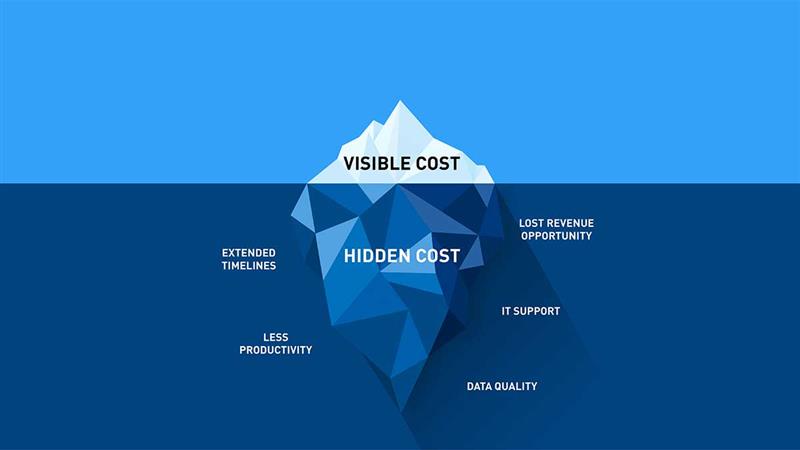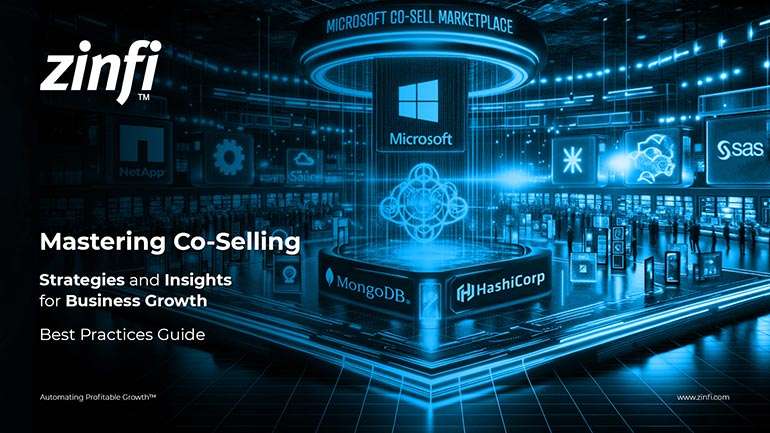Best Practices Articles

Partner Relationship Management: Hidden Costs of Poor Integration Planning
When organizations use a partner relationship management (PRM) system, they often feel excited. This excitement comes from the system's promises. These include better partner engagement, easier workflows, and improved performance tracking.
While these benefits are substantial, achieving them requires careful integration planning. PRM implementation can become an expensive and disruptive challenge without a clear and strategic approach.
Poor integration planning can lead to hidden costs. These costs may not be clear at first. However, they can have long-term effects on finances, operations, and reputation.
These include delays, excessive IT maintenance costs, data quality issues, employee productivity loss, and missed revenue opportunities. Organizations that ignore these risks might struggle to get the most value from their PRM systems. Managing risks is important for achieving a good Return on Investment (ROI).
This article will look at the hidden costs of poor integration planning for partner relationship management projects. The article highlights common challenges and offer practical strategies for successful integration.
Why Integration Planning is Critical for PRM Success
Before we discuss the costs of bad planning, we need to understand how partner relationship management software works. This is important in today's partner ecosystems. PRM systems centralize partner data, automate partner workflows, and provide real-time insights into partner performance. When integrated effectively with other tools like CRM (Salesforce, HubSpot) and ERP systems, PRM solutions can:
- Enhance Partner Collaboration: Automate communication, enable shared visibility and improve trust.
- Increase Sales Efficiency: Help sales teams identify opportunities for upselling and cross-selling.
- Improve Decision-Making: Provide accurate insights to optimize partner programs and incentives.
- Boost Operational Efficiency: Reduce manual processes and errors, allowing teams to focus on strategy.
However, you can only attain these benefits when you plan integration strategically and execute it seamlessly. Without proper planning, businesses may face unintended consequences, ranging from operational disruptions to partner dissatisfaction.
Hidden Costs of Poor PRM Integration Planning
1. Project Delays and Extended Timelines
One of the most common challenges organizations face is delays during PRM integration. Businesses want quick implementation. However, integrating a PRM system with current systems, like CRMs and ERPs, can be complex.
Common Causes of Delays:
- Incomplete understanding of system requirements.
- Poor data mapping between PRM and other systems.
- Overlooked customization needs.
- Insufficient testing and validation processes.
Every delay increases the total cost of the project. Labor costs escalate as IT teams and external consultants spend additional time troubleshooting issues. Delays can disrupt critical business activities like partner onboarding, incentive rollouts, and sales campaigns.
The Business Impact of Delays
Consider a technology company that planned to integrate partner management software to prepare for a new product launch. Because of bad planning, the integration faced many delays.
Partners could not access marketing materials or incentives on time. The result? Reduced partner engagement, lower sales, and damaged trust.
Solution: Organizations should create a phased implementation roadmap with clear milestones, timelines, and risk mitigation strategies. Conduct pre-integration testing to identify potential bottlenecks.
2. Rising IT Support and Maintenance Costs
A poorly integrated partner relationship management system often requires ongoing IT support to resolve system errors, compatibility issues, and performance lags. Over time, these challenges lead to increased maintenance costs that exceed the project’s initial budget.
IT Challenges Include:
- System Compatibility Issues: PRM software may fail to communicate effectively with CRM, ERP, or partner portals.
- Data Synchronization Errors: Misaligned data causes recurring errors and inefficiencies.
- Ongoing Troubleshooting: Frequent system crashes or performance slowdowns force IT teams to step in repeatedly.
The Long-Term Cost of IT Inefficiencies
IT teams experience elevated labor expenditures. Important projects like innovation and improving business processes also pull them away. This impacts overall business agility and growth.
Example: An enterprise that integrated partner relationship management software without proper testing faced recurring system errors, requiring continuous IT intervention. Over the course of one year, IT maintenance costs increased by 30%. This increase made it hard for the company to use resources for other important tasks.
Solution: Use automation tools, middleware platforms, and pre-built connectors to ensure system compatibility. Prioritize extensive pre-launch testing to reduce maintenance costs.
3. Compromised Data Quality
Data quality is a cornerstone of successful partner relationship management. Accurate and reliable data enables businesses to track partner performance, deliver targeted incentives, and identify growth opportunities. However, poor integration planning often results in data quality issues, such as:
- Duplicate partner records.
- Partner profiles that lack completeness.
- Incorrect data mapping between systems.
The Consequences of Poor Data Quality
- Ineffective Decision-Making: Leaders make flawed decisions based on inaccurate partner data.
- Missed Revenue Opportunities: Incomplete partner insights prevent sales teams from identifying upselling and cross-selling opportunities.
- Partner Frustration: Partners may lose trust if incentive calculations or performance reports are inaccurate.
For example, a global reseller network had major problems. Its partner management software did not sync well with its CRM. Confusion over duplicate partner records delayed incentive payouts and declined partner satisfaction.
Solution: Implement robust data governance policies, conduct regular data audits, and leverage automated data validation and cleaning tools.
4. Reduced Employee Productivity
When systems are poorly integrated, employees are forced to rely on manual workarounds. Teams waste time fixing errors, moving data between systems, or solving compatibility problems. They should focus on their main tasks instead.
Examples of Productivity Loss:
- Sales teams manually input partner data into CRM and PRM systems.
- Marketing teams are struggling to access updated partner insights for campaigns.
- IT teams repeatedly resolve errors caused by poor integration.
Over time, these inefficiencies reduce overall productivity and increase the risk of human error.
Solution: Automate data transfer between PRM and other systems using middleware solutions and integration platforms. Train employees to adapt to the integrated system and workflows.
5. Missed Revenue Opportunities
Perhaps the most significant hidden cost of poor partner relationship management integration planning is the loss of revenue opportunities. Inefficient systems prevent organizations from identifying high-performing partners, delivering timely incentives, and executing targeted sales strategies.
Revenue Risks Include:
- Failure to Identify High-Value Partners: Data inaccuracies prevent businesses from recognizing top-performing partners.
- Delayed Incentive Programs: Poor integration slows the rollout of partner rewards, reducing partner motivation.
- Limited Visibility: Sales teams lack insights into partner activities, leading to missed opportunities for upselling and cross-selling.
For example, a retail business that postponed partner relationship management integration during the holiday season missed important promotions. This led to millions in lost sales.
Solution: Ensure seamless integration to provide real-time visibility into partner performance. Align sales, marketing, and partner programs to maximize growth opportunities.

Strategies to Avoid Hidden Costs
Organizations must adopt a proactive and structured approach to avoid the hidden costs of poor partner relationship management integration.
- Create a Detailed Integration Plan: Define project goals, timelines, and milestones. Anticipate challenges and develop contingency plans.
- Invest in the Right Tools: Use middleware, automation platforms, and data mapping tools to ensure seamless integration.
- Prioritize Data Governance: Implement policies for data entry, validation, and audits to maintain accuracy.
- Engage Stakeholders: Involve IT, sales, and marketing teams early to ensure alignment and minimize resistance to change.
- Conduct Thorough Testing: Test the partner relationship management system extensively before launch to identify and resolve potential issues.
- Monitor Performance Continuously: Regularly audit system performance, gather user feedback, and address any challenges promptly.
Case Study: The Value of Proactive Integration Planning
Company A rushed through partner relationship management integration and faced recurring system errors, rising IT costs, and missed revenue opportunities.
Company B, however, adopted a proactive approach:
- Developed a detailed plan with clear milestones.
- Used middleware tools to ensure seamless data transfer.
- Trained employees on the new system and workflows.
As a result, Company B achieved smooth integration, improved partner collaboration, and a measurable increase in revenue.
Company B's success story highlights the importance of careful planning and execution in partner relationship management. By taking the time to develop a comprehensive strategy, they not only avoided the pitfalls that the other company faced but also set themselves up for long-term success.
Foster Strong Communication: One of the key elements in Company B's approach was establishing open lines of communication among all stakeholders. Regular meetings and updates ensured that everyone was on the same page, which helped to quickly address any concerns or questions that arose during the integration process. This collaborative environment fostered trust and encouraged team members to share insights that could further enhance the system's effectiveness.
Invest in Training and Support: Company B recognized that technology is only as good as the people using it. They invested in thorough training sessions for their employees, ensuring that everyone felt confident in navigating the new system. Additionally, they provided ongoing support, including a dedicated help desk and resources for troubleshooting common issues. This commitment to employee development not only improved system adoption but also empowered staff to leverage the full capabilities of the partner relationship management system.
Measure Success with Key Performance Indicators (KPIs): To gauge the effectiveness of their integration, Company B established clear KPIs. These metrics included partner satisfaction scores, response times to partner inquiries, and revenue growth attributed to improved collaboration. By regularly reviewing these indicators, they could make data-driven decisions to refine their processes and enhance partner relationships further.
Adapt and Evolve: The business landscape is constantly changing, and Company B understood the importance of remaining agile. They committed to regularly revisiting their partner relationship management strategy, adapting it as necessary to meet evolving market demands and partner needs. This flexibility allowed them to stay ahead of the competition and maintain strong, productive partnerships.
The experiences of Company A and Company B serve as valuable lessons for organizations looking to implement or improve their partner relationship management systems. By prioritizing thorough testing, continuous monitoring, effective communication, employee training, and adaptability, companies can create a robust framework that not only enhances partner collaboration but also drives sustainable growth.
Conclusion
The hidden costs of poor partner relationship management integration planning can erode profitability, hinder productivity, and damage partner relationships. Organizations must prioritize strategic planning, stakeholder collaboration, and data quality to avoid these challenges.
Businesses can benefit from their PRM systems by planning well. They should use reliable partner management software. Automation tools can also help improve efficiency. A successful integration enhances partner performance and positions organizations for sustainable growth.
Best Practices Guidebook
 The Ultimate Guide to Partner Marketing Success Best Practices
The Ultimate Guide to Partner Marketing Success Best PracticesDownload Guide
 How to Start and Scale Partner Ecosystems Best Practices
How to Start and Scale Partner Ecosystems Best PracticesDownload Guide
 The Evolution of PartnerOps: Past, Present & Future Best Practices
The Evolution of PartnerOps: Past, Present & Future Best PracticesDownload Guide
 Mastering Channel Sales: Strategies, Best Practices, and Growth Tactics for 2025
Mastering Channel Sales: Strategies, Best Practices, and Growth Tactics for 2025Download Guide
 Winning with Partner Advisory Councils: Best Practices for Partner Engagement & Growth
Winning with Partner Advisory Councils: Best Practices for Partner Engagement & GrowthDownload Guide
 The Future of Partner Ecosystems Best Practices
The Future of Partner Ecosystems Best PracticesDownload Guide
 The AI Revolution: How Technology and Talent are Shaping the Future
The AI Revolution: How Technology and Talent are Shaping the FutureDownload Guide
 Top 105 Partner Management Metrics that Matter Best Practices
Top 105 Partner Management Metrics that Matter Best PracticesDownload Guide
 Mastering PRM Integration Best Practices
Mastering PRM Integration Best PracticesDownload Guide
 Building a Sales Partner Portal with Salesforce Best Practices
Building a Sales Partner Portal with Salesforce Best PracticesDownload Guide
 Building and Managing Partner Ecosystems Best Practices
Building and Managing Partner Ecosystems Best PracticesDownload Guide
 Mastering Co-Marketing and Co-Selling Best Practices
Mastering Co-Marketing and Co-Selling Best PracticesDownload Guide
 Transforming Partner Ecosystems Best Practices
Transforming Partner Ecosystems Best PracticesDownload Guide
 Mastering Partner Ecosystems Best Practices
Mastering Partner Ecosystems Best PracticesDownload Guide
 Mastering Partner Onboarding Best Practices
Mastering Partner Onboarding Best PracticesDownload Guide
 Partner Ecosystem Management Best Practices
Partner Ecosystem Management Best PracticesDownload Guide
 B2B Marketing in the Age of Intelligence Best Practices
B2B Marketing in the Age of Intelligence Best PracticesDownload Guide
 Multi-Partner Co-Selling Best Practices
Multi-Partner Co-Selling Best PracticesDownload Guide







